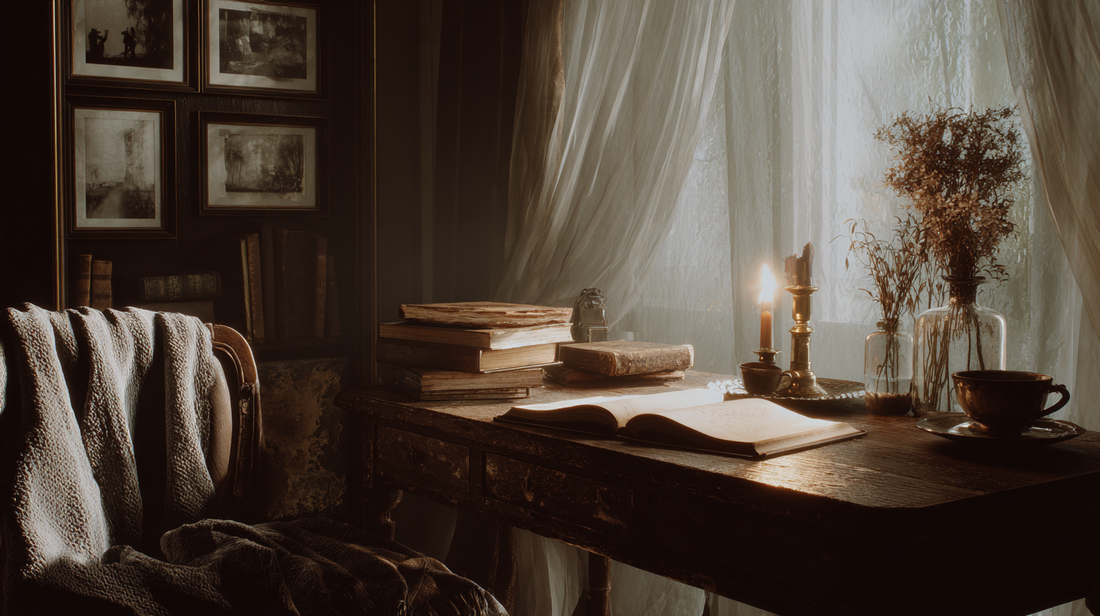
Why We Find Comfort in the Macabre: Five Hauntings of the Self
Share
Gothic Escapism, Told Through Fictional Fragments
"We are each haunted in our own way. Some by memory. Some by longing. Some by the quiet absence of noise we never knew we missed."
Gothic subcultures have long been misunderstood as an obsession with death or decay, but that misses the point entirely. What draws us into the macabre isn’t morbidity. It’s meaning.
To wear black is to signal clarity in chaos. To walk among ruins is to know what it means to endure. The ghost stories we tell ourselves are often softer than the reality we live in.
What follows, is a series of portraits: five fictional fragments. Each channeling a different kind of comfort found in dread, sorrow, or the supernatural. If one of them sounds like you, maybe that’s no coincidence.
I. The Widow Who Refused to Bury Her Love
Southern Gothic / Gothic Romance
Eliza Boone hadn’t left Cypress Hollow in 47 years. Not since the funeral.
They buried Thomas with a hymn and a bottle of his grandfather’s whiskey, beneath a tree that split from lightning the next summer. The house creaked a little louder after that. The rocking chair on the porch stopped rocking. But Eliza stayed.
Every morning she lit the stove with matches he had struck. Every evening she poured two cups of chicory coffee, one into her blue porcelain, the other into a chipped mug that hadn’t been washed since 1976.
The town whispered. Said she was cursed, or cracked. Said the house should be condemned. But when the preacher’s wife asked, gently, why she never thought of moving, Eliza smiled and said,
“There’s more of him here than out there.”
On Sundays she wore her wedding dress like a robe, tattered lace, yellowed seams, red clay near the hem. When the wind blew through the cracked windows, it carried his voice, low and patient, asking her to dance. And she would. Alone in the parlor. Waltzing to a hymn only she could hear.
Between the lines:
We don’t always bury the dead. Not because we can’t. Because we won’t. Grief becomes a room we furnish. Southern Gothic teaches us that comfort can come from keeping company with loss.
II. The Ghost in Apartment 4C
Modern Gothic / Ghost Story
The lease says it’s vacant. The mail slot hasn’t been touched. The neighbors never saw her move in.
But they hear her.
Soft piano at 3:17 a.m.
The light flickering behind the curtains.
A shadow at the window, just after storms.
She lives alone. She is alone. But the walls remember.
She reads medical textbooks for fun and underlines things like “anhedonia” and “liminal affect.” Her clothing is loose, clean, black — the kind you forget you’re wearing. Her scent is jasmine and ash. Her presence is absence.
Every Friday she presses a flower in a notebook labeled Unsent Letters. No one knows what she does for work. No one knows her name.
But when a neighbor lost their cat, they found it curled on her doorstep. Asleep, safe, and warm.
Between the lines:
She is what so many of us feel like: unseen, unspoken, and still reaching. The ghost is not the threat. The ghost is the feeling that no one noticed you were gone. And in the stillness of that, there is peace.
III. The Librarian Who Died of Longing
Gothic Romance
They say Miss Everly used to read aloud when she thought no one was listening. Sonnets, mostly. Sometimes passages from Poe that made her cry.
She shelved books by memory and smell, not call number. Her fingers always smelled like old paper and sandalwood. She once told a student, “A good book never ends. It just closes its eyes.”
She was always alone. Rumors said she wrote letters to a man who never replied. Others claimed she once turned down a marriage proposal from a man who wore shoes too shiny.
One day, she simply stopped moving, right there in aisle 7B, holding La Belle Dame Sans Merci in both hands. When they found her, the book was open to the line:
“And no birds sing.”
She was buried in velvet and lace, under a tombstone that read: Loved in Silence.
Between the lines:
Romantic goths don’t want perfection. They want beauty that aches. To love is to suffer with grace. To long, forever, and still call it a gift.
IV. The Stranger Who Dances with Wolves
Byronic Hero
He walks with a limp no one asks about. His coat is always buttoned wrong, but never by accident. He carries a book he never opens and a cigarette he never lights.
He comes when the oil lamps flicker and the last hymn fades from the street outside. Not hunting drink or mercy. Just standing by the mirror behind the bar, watching a reflection that never quite belongs to him.
No one knows his real name. They call him Mercy’s Ghost, after the woman whose grave he visits every year on the same day, wearing the same gloves, leaving the same blood-red rose.
He doesn’t flirt. He warns.
He doesn’t kiss. He confesses.
And if he ever laughs, it’s only at himself.
Between the lines:
Some of us want a love that mirrors our damage. The Byronic hero is not a fantasy, he’s a reflection. We’re drawn to the tragic not because we want to save them… but because we see ourselves in the ruin.
V. The Man Who Ate With Monsters
Gothic Horror
He lives in the chapel basement. Says he used to be a priest. Says it without laughing.
At dusk, he sets five places: one for him, four for the things that knock.
A bowl of bone broth. A glass of water with rust. A prayer whispered in a language older than grief.
He never tries to run.
He never locks the door.
People in the town call him crazy. But the monsters never hurt anyone else. They eat, they whisper, and they leave.
When a traveler once asked how he could bear to dine with devils, the man shrugged and said,
“Better to invite them in than wait for them to break down the door.”
Between the lines:
Gothic horror reminds us fear made familiar, becomes less frightening. When we befriend the monsters, we take away their power. It’s not weakness. It’s strategy.
Which of these haunted you most?
Was it Eliza’s grief? The piano in 4C? The rose left on a grave?
Or did you see yourself in the monster’s dinner guest?
Let us know in the comments. You’re not alone in the dark. We’re here, too.






